www.altairhyperworks.com | HyperWorks is a division of
�
Altair Engineering Contact Information
Web site
www.altairhyperworks.com
FTP site
Location
Australia
Brazil
China
France
Address:
Login:
Password:
ftp.altair.com or ftp2.altair.com or http://ftp.altair.com/ftp
ftp
Telephone
61.3.9016.9042
55.11.3884.0414
86.21.6117.1666
33.1.4133.0992
e-mail
anzsupport@altair.com
br_support@altair.com
support@altair.com.cn
francesupport@altair.com
Germany
49.7031.6208.22
hwsupport@altair.de
91.80. 6629.4500
1.800.425.0234 (toll free)
support@india.altair.com
support@altairengineering.it
support@altairjp.co.jp
support@altair.co.kr
anzsupport@altair.com
hwsupport@altair.com
India
Italy
Japan
Korea
39.800.905.595
81.3.5396.2881
82.31.716.4321
New Zealand
64.9.413.7981
North America
248.614.2425
Scandinavia
46.46.286.2052
support@altair.se
United Kingdom
01926.468.600
support@uk.altair.com
The following countries have distributors for Altair Engineering:
Asia Pacific: Indonesia, Malaysia, Singapore, Taiwan, Thailand
Europe: Czech Republic, Hungary, Poland, Romania, Spain, Turkey.
Copyright© Altair Engineering Inc. All Rights Reserved for:
HyperMesh® 1990-2013; HyperCrash® 2001-2013; OptiStruct® 1996-2013; RADIOSS®1986-2013; HyperView®1999-2013;
HyperView Player® 2001-2013; HyperStudy® 1999-2013; HyperGraph®1995-2013; MotionView® 1993-2013; MotionSolve® 2002-
2013; HyperForm® 1998-2013; HyperXtrude® 1999-2013; Process Manager™ 2003-2013; Templex™ 1990-2013; MediaView™
1999-2013; BatchMesher™ 2003-2013; TextView™ 1996-2013; HyperMath® 2007-2013; ScriptView™ 2007-2013; Manufacturing
Solutions™ 2005-2013; HyperWeld® 2009-2013; HyperMold® 2009-2013; solidThinking® 1993-2013; solidThinking Inspire™
2009-2013; solidThinking Evolve™ 1993-2013; Durability Director™ 2009-2013; Suspension Director™ 2009-2013; AcuSolve®
1997-2013; and AcuConsole® 2006-2013.
In addition to HyperWorks® trademarks noted above, GridWorks™, PBS GridWorks®, PBS Professional®, PBS™, PBS Works™
and Portable Batch System® are trademarks of ALTAIR ENGINEERING INC. All are protected under U.S. and international laws
and treaties. Copyright© 1994-2013.
Additionally, the Altair software is protected under patent #6,859,792 and other patents pending.
All other marks are the property of their respective owners.
ALTAIR ENGINEERING INC. Proprietary and Confidential. Contains Trade Secret Information. Not for use or disclosure outside of
ALTAIR and its licensed clients. Information contained in HyperWorks® shall not be decompiled, disassembled, or “unlocked”,
reverse translated, reverse engineered, or publicly displayed or publicly performed in any manner. Usage of the software is only as
explicitly permitted in the end user software license agreement.
Copyright notice does not imply publication.
�
Table of Contents
OptiStruct Optimization
Analysis, Concept and Optimization
Table of Contents .................................................................................................................... 1
Chapter 1: Introduction ............................................................................................ 7
1 – HyperWorks Overview ............................................................................................... 7
1.1 – HyperWorks Tool Descriptions ............................................................................... 8
1.2 – OptiStruct Integration with HyperWorks ................................................................ 10
2 – OptiStruct Overview ................................................................................................ 11
2.1 – Finite Element Analysis ........................................................................................ 11
2.2 – Multi-body Dynamic Analysis ................................................................................ 12
2.3 – Structural Design and Optimization ...................................................................... 12
2.4 – Case Studies ........................................................................................................ 15
2.4.1 – Lightweight SUV Frame Development ............................................................... 15
2.4.2 – Optimization Process of a Torsion Link .............................................................. 16
Chapter 2: Theoretical Background ...................................................................... 17
1 – Optimization ............................................................................................................ 17
1.1 – Design Variable .................................................................................................... 17
1.2 – Response ............................................................................................................. 19
1.2.1 – Subcase Independent Response ....................................................................... 19
1.3 – Objective Function ................................................................................................ 25
1.4 – Constraint Functions............................................................................................. 25
2 – Gradient-based Optimization ................................................................................... 29
2.1 – Gradient Method ................................................................................................... 30
2.2 – Sensitivity Analysis ............................................................................................... 31
2.3 – Move Limit Adjustments ....................................................................................... 35
3
Proprietary Information of Altair Engineering, Inc.
HyperWorks 12.0
�
2.4 – Constraint Screening ............................................................................................ 35
2.4.1 – Regions and Their Purpose ............................................................................... 37
2.5 – Discrete Design Variables .................................................................................... 38
Exercise 2.1: Getting Started using Inspire .................................................................... 39
Exercise 2.2: Topology Optimization Using Multiple Load Cases in Inspire ................... 55
Chapter 3: HyperMesh Optimization Interface ..................................................... 97
1 – Model Definition Structure ....................................................................................... 97
1.1 – Input/Output Section ............................................................................................. 98
1.2 – Subcase Information Section .............................................................................. 101
1.3 – Bulk Data Section ............................................................................................... 101
2 – Optimization Setup ................................................................................................ 102
2.1 – Optimization GUI ................................................................................................ 102
2.2 – Design Variable [ DTPL] ..................................................................................... 103
2.3 – Responses [DRESP1] ........................................................................................ 104
2.4 – Dconstraints [DCONSTR] ................................................................................... 105
2.5 – Obj. reference [DOBJREF] ................................................................................. 106
2.6 – Objective [DESOBJ] ........................................................................................... 107
2.7 – Table entries [DTABLE] ...................................................................................... 108
2.8 – Dequations [DEQATN] ....................................................................................... 109
2.9 – Discrete DVs [DDVAL] ........................................................................................ 110
2.10 – Opti. control [DOPTPRM] ................................................................................. 111
2.11 – Constr. Screen [DSCREEN] ............................................................................. 112
3 – How to Setup an Optimization in HyperMesh ........................................................ 113
Chapter 4: Concept Design ................................................................................. 119
1 – Topology Optimization .......................................................................................... 119
1.1 – Homogenization method ..................................................................................... 120
1.2 – Density method .................................................................................................. 120
HyperWorks 12.0
Proprietary Information of Altair Engineering, Inc.
4
�
Exercise 4.1 – Topology Optimization of a Hook with Stress Constraints .................... 121
Exercise 4.2 – Topology Optimization of a Control Arm ............................................... 129
Exercise 4.3: Pattern Repetition using Topology Optimization ..................................... 135
2 – Topography Optimization ...................................................................................... 141
2.1 – Design Variables for Topography Optimization ................................................... 141
2.1.1 – Variable Generation ......................................................................................... 142
2.1.2 – Multiple Topography Design Regions .............................................................. 143
Exercise 4.4 – Topography Optimization of an L-Bracket Including Autobead
Reinterpretation ........................................................................................................... 147
3 – Free-size Optimization........................................................................................... 155
Exercise 4.5 – Free-size optimization of Finite Plate with hole .................................... 161
4 – Design Interpretation - OSSmooth ......................................................................... 169
4.1 – OSSmooth Input Data ........................................................................................ 171
4.2 – Running OSSmooth ........................................................................................... 173
4.3 – Interpretation of Topography Optimization Results ............................................. 174
4.4 – Shape Optimization Results, Surface Reduction and Surface Smoothing ........... 175
Exercise 4.6 – OSSmooth surfaces from a topology optimization ................................ 177
Chapter 5: Fine-Tuning ........................................................................................ 181
1 – Size Optimization .................................................................................................. 181
1.1 – Design Variables for Size Optimization ............................................................... 182
Exercise 5.1 – Size Optimization of a Rail Joint ........................................................... 183
Exercise 5.2 – Discrete Size Optimization of a Welded Bracket .................................. 191
2 – Shape Optimization ............................................................................................... 199
2.1 – Design Variables for Shape Optimization ........................................................... 200
2.2 – HyperMorph ....................................................................................................... 201
2.2.1 – The Three Basic Approaches to Morphing ....................................................... 201
Exercise 5.3 – Cantilever L-beam Shape Optimization ................................................ 203
Exercise 5.4 – Shape Optimization of a Rail Joint ....................................................... 229
5
Proprietary Information of Altair Engineering, Inc.
HyperWorks 12.0
�
3 – Free-shape Optimization ....................................................................................... 229
3.1 – Defining Free-shape Design Regions ................................................................. 229
3.2 – Free-shape Parameters ...................................................................................... 231
3.2.1 – Direction type .................................................................................................. 231
3.2.2 – Move factor ..................................................................................................... 232
3.2.3 – Number of layers for mesh smoothing ............................................................. 232
3.2.4 – Maximum shrinkage and growth ...................................................................... 233
3.2.5 – Constraints on Grids in the Design Region ...................................................... 234
Exercise 5.5 – Free-shape Optimization of a Compressor Bracket .............................. 237
Exercise 5.6 - Shape Optimization of a 3-D Bracket using the Free-shape Method .... 245
Appendix A ........................................................................................................... 255
HyperWorks 12.0
Proprietary Information of Altair Engineering, Inc.
6
�
Chapter 1: Introduction
Chapter 1
Introduction
1- HyperWorks Overview
HyperWorks®, A Platform for Innovation™, is an enterprise simulation solution for rapid
design exploration and decision-making. As one of the most comprehensive CAE solutions
in the industry, HyperWorks provides a tightly integrated suite of best-in-class tools for:
o Modeling
o Analysis
o Optimization
o Visualization
o Reporting
o Performance data management.
Based on a revolutionary “pay-for-use” token-based business model, HyperWorks delivers
increased value and flexibility over other software licensing models.
Below we list the applications that are part of HyperWorks, for extra information about them
go to www.altairhyperworks.com web page or go to HyperWorks online documentation.
HyperWorks 12.0
Proprietary Information of Altair Engineering, Inc.
OptiStruct Optimization 7
�
Chapter 1: Introduction
1.1 – HyperWorks Tool Descriptions
Finite Element Meshing and Modeling
HyperMesh
HyperCrash
BatchMesher
Multi-body Dynamics Modeling
MotionView
Solvers
RADIOSS
MotionSolve
OptiStruct
Post-processing and Data Analysis
HyperView
HyperGraph
HyperGraph 3D
HyperView Player
Study and Optimization
HyperStudy
Data Management and Process Automation
Altair Data Manager
Process Manager
Assembler
Universal finite element pre- and post-processor
Finite element pre-processor for automotive crash and
safety analysis
Geometry cleanup and auto-meshing in batch mode for
given CAD files
Multi-body dynamics pre- and post-processor
Finite element solver for linear and non-linear problems
Multi-body dynamics solver
Design and optimization software using finite elements
and multi-body dynamics
High performance finite element and mechanical
system post-processor, engineering plotter, and data
analysis tool
Engineering plotter and data analysis tool
Engineering 3-D plotter and data analysis tool
Viewer for visualizing 3-D CAE results via the Internet
or desktop
Integrated optimization, DOE, and robustness engine
A solution that organizes, manages, and stores CAE
and test data throughout the product design cycle
Process automation tool for HyperWorks and third
party software; Processes can be created with the help
of Process Studio.
A tool that enables CAE analysts to manage, organize,
and control their CAE mesh data
OptiStruct Optimization 8
Proprietary Information of Altair Engineering, Inc.
HyperWorks 12.0
�
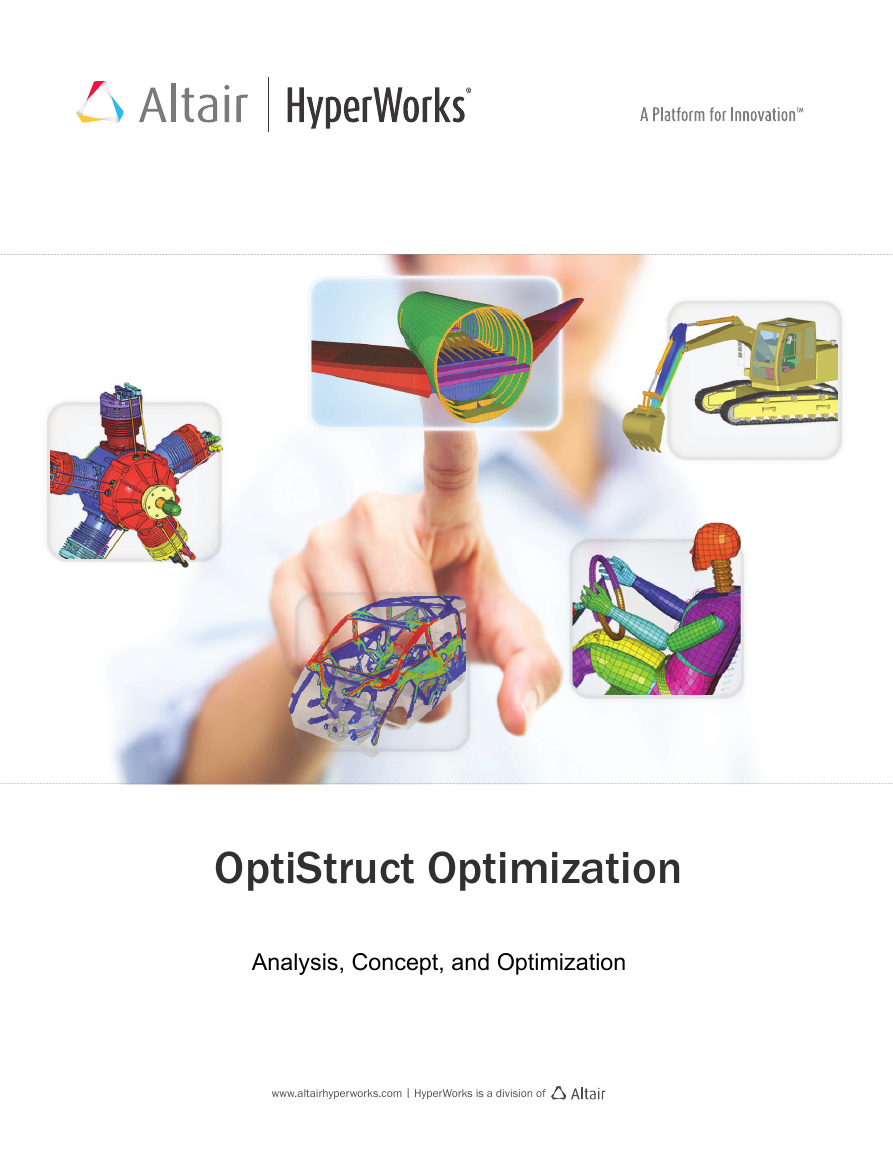
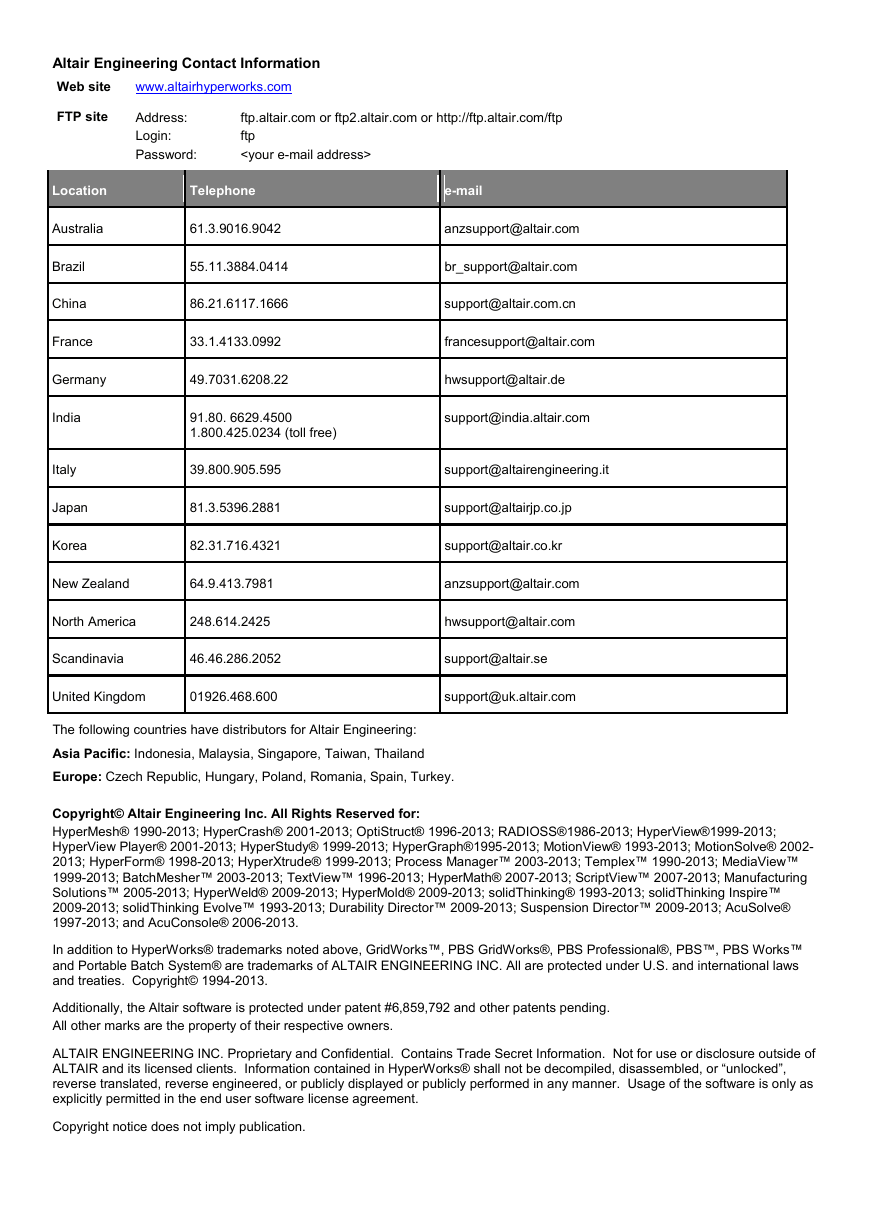
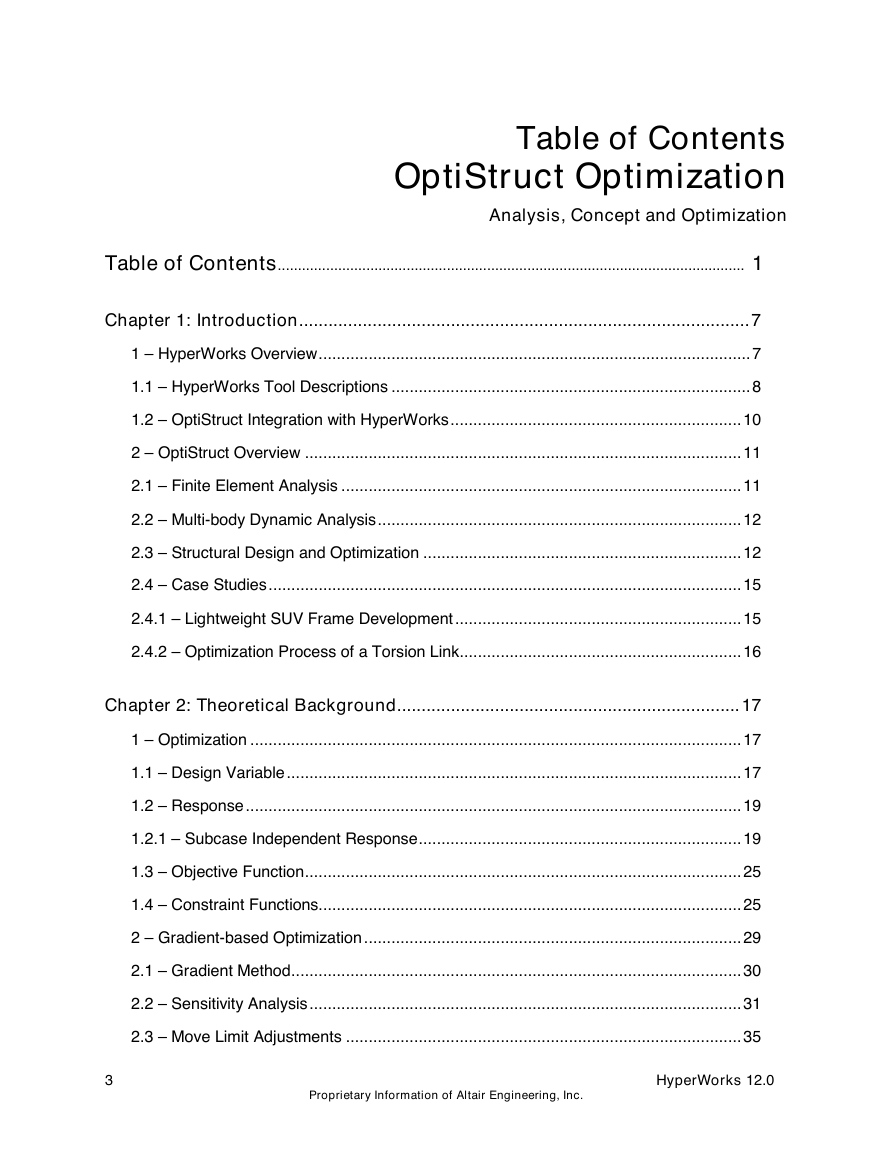

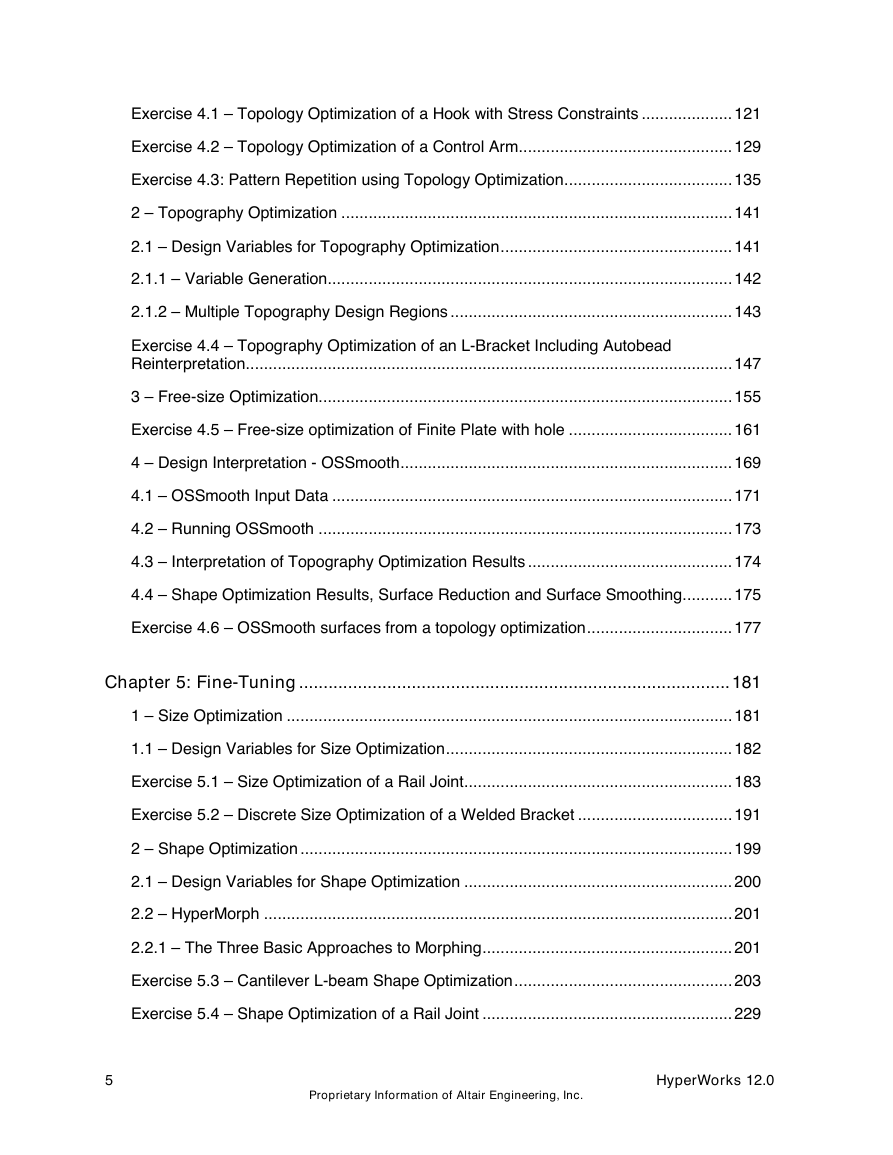
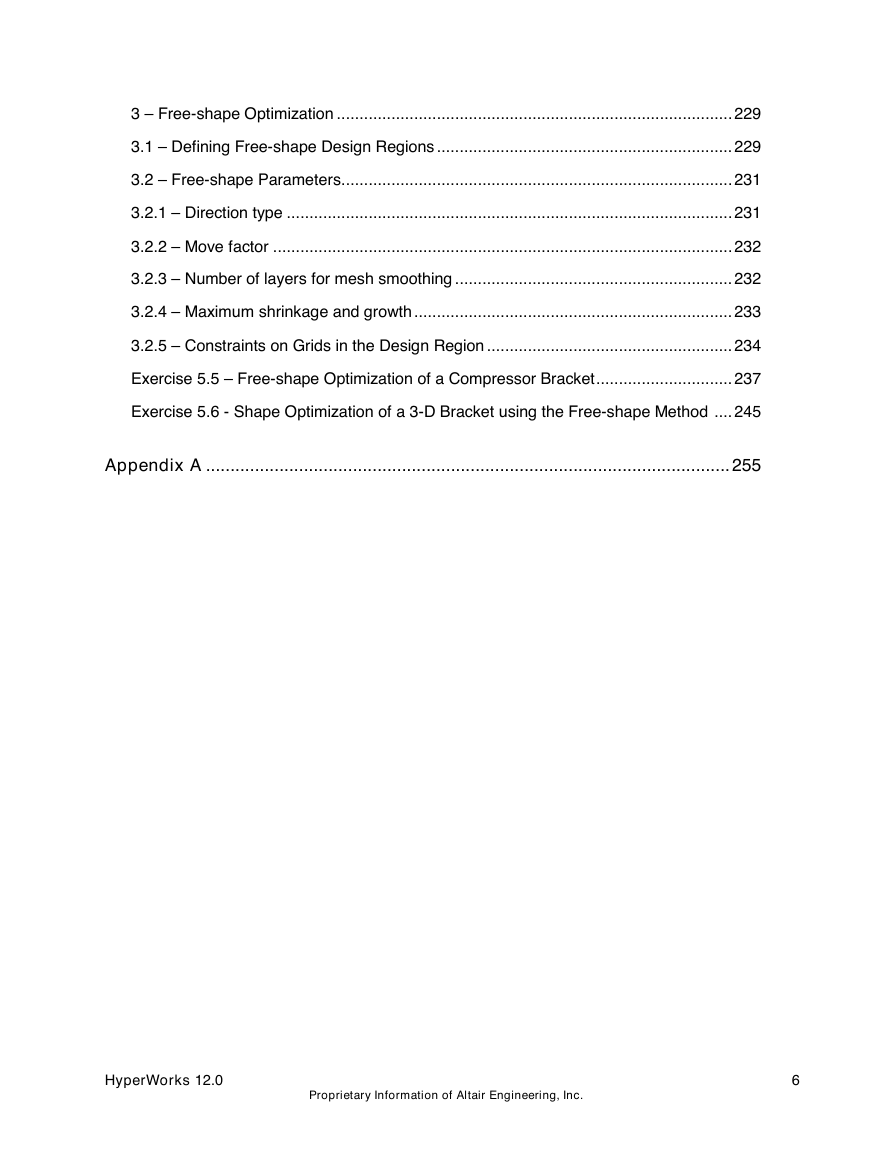
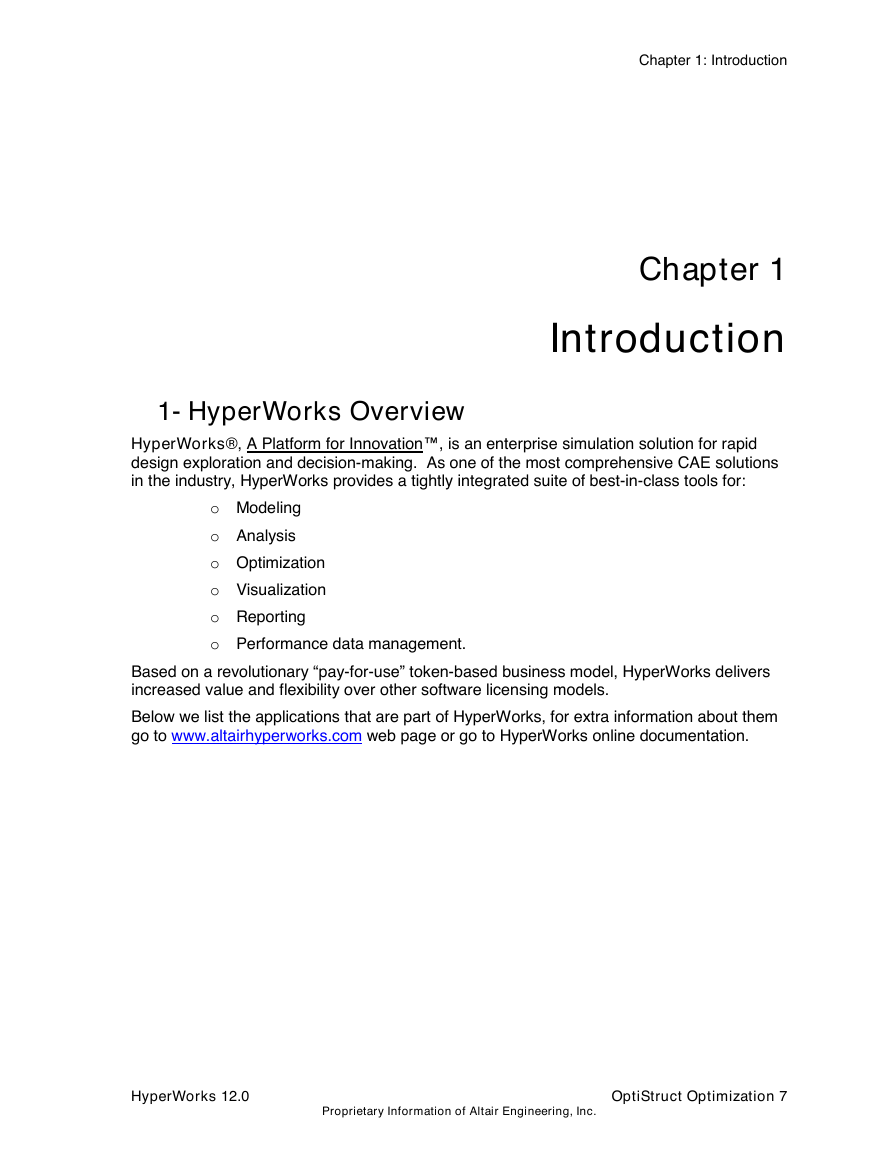
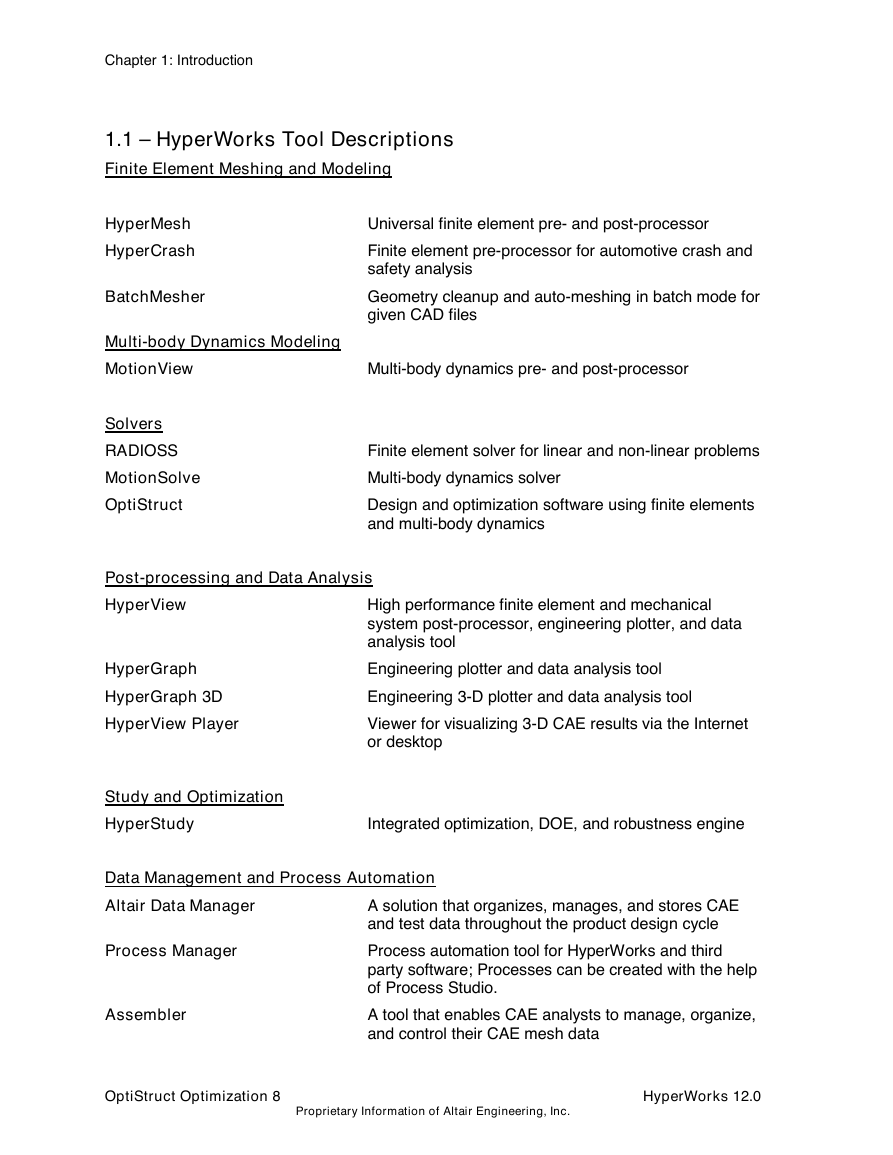








 2023年江西萍乡中考道德与法治真题及答案.doc
2023年江西萍乡中考道德与法治真题及答案.doc 2012年重庆南川中考生物真题及答案.doc
2012年重庆南川中考生物真题及答案.doc 2013年江西师范大学地理学综合及文艺理论基础考研真题.doc
2013年江西师范大学地理学综合及文艺理论基础考研真题.doc 2020年四川甘孜小升初语文真题及答案I卷.doc
2020年四川甘孜小升初语文真题及答案I卷.doc 2020年注册岩土工程师专业基础考试真题及答案.doc
2020年注册岩土工程师专业基础考试真题及答案.doc 2023-2024学年福建省厦门市九年级上学期数学月考试题及答案.doc
2023-2024学年福建省厦门市九年级上学期数学月考试题及答案.doc 2021-2022学年辽宁省沈阳市大东区九年级上学期语文期末试题及答案.doc
2021-2022学年辽宁省沈阳市大东区九年级上学期语文期末试题及答案.doc 2022-2023学年北京东城区初三第一学期物理期末试卷及答案.doc
2022-2023学年北京东城区初三第一学期物理期末试卷及答案.doc 2018上半年江西教师资格初中地理学科知识与教学能力真题及答案.doc
2018上半年江西教师资格初中地理学科知识与教学能力真题及答案.doc 2012年河北国家公务员申论考试真题及答案-省级.doc
2012年河北国家公务员申论考试真题及答案-省级.doc 2020-2021学年江苏省扬州市江都区邵樊片九年级上学期数学第一次质量检测试题及答案.doc
2020-2021学年江苏省扬州市江都区邵樊片九年级上学期数学第一次质量检测试题及答案.doc 2022下半年黑龙江教师资格证中学综合素质真题及答案.doc
2022下半年黑龙江教师资格证中学综合素质真题及答案.doc